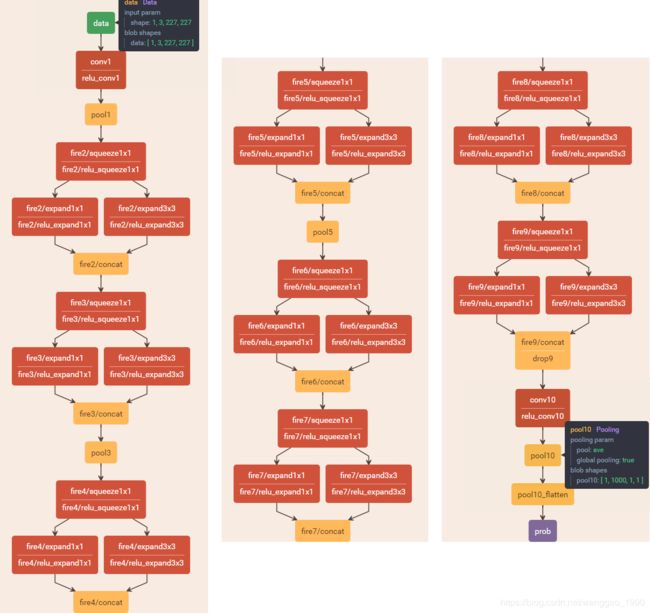opencv dnn模块 示例(1) 图像分类 classification
1、网络结构
squeezenet_v1.1.prototxt
官方标题为 SqueezeNet: AlexNet-level accuracy with 50x fewer parameters and <1MB model size。
输入data层的blob shape为[1,3,227,227],输出prob的shape为[1,1000]。

2、示例代码
c++代码和python代码分别如下
(1) c++代码如下
#include (2) python代码如下
import cv2 as cv
import numpy as np
from common import *
#backends = (cv.dnn.DNN_BACKEND_DEFAULT, cv.dnn.DNN_BACKEND_HALIDE, cv.dnn.DNN_BACKEND_INFERENCE_ENGINE, cv.dnn.DNN_BACKEND_OPENCV)
#targets = (cv.dnn.DNN_TARGET_CPU, cv.dnn.DNN_TARGET_OPENCL, cv.dnn.DNN_TARGET_OPENCL_FP16, cv.dnn.DNN_TARGET_MYRIAD)
class MyArgs:
pass
args = MyArgs()
args.model = "../data/testdata/dnn/squeezenet_v1.1.prototxt"
args.config = "../data/testdata/dnn/squeezenet_v1.1.caffemodel"
args.classes = "../data/dnn/classification_classes_ILSVRC2012.txt"
args.backend = cv.dnn.DNN_BACKEND_DEFAULT
args.target = cv.dnn.DNN_TARGET_OPENCL
args.scale = 1.0
args.mean = (0,0,0)
args.rgb = False
args.input = None
# Load names of classes
classes = None
if args.classes:
with open(args.classes, 'rt') as f:
classes = f.read().rstrip('\n').split('\n')
# Load a network
#net = cv.dnn.readNet(args.model, args.config, args.framework)
net = cv.dnn.readNetFromCaffe(args.model, args.config)
net.setPreferableBackend(args.backend)
net.setPreferableTarget(args.target)
winName = 'Deep learning image classification in OpenCV'
cv.namedWindow(winName, cv.WINDOW_NORMAL)
cap = cv.VideoCapture(args.input if args.input else 0)
while cv.waitKey(1) < 0:
hasFrame, frame = cap.read()
if not hasFrame:
cv.waitKey(1)
break
# Create a 4D blob from a frame.
inpWidth = frame.shape[1]
inpHeight = frame.shape[0]
blob = cv.dnn.blobFromImage(frame, args.scale, (inpWidth, inpHeight), args.mean, args.rgb, crop=False)
# Run a model
net.setInput(blob)
out = net.forward()
# Get a class with a highest score.
out = out.flatten()
#classId = np.argmax(out)
#confidence = out[classId]
_,confidence,_,classId = cv.minMaxLoc(out)
classId = classId[1]
# Put efficiency information.
t, _ = net.getPerfProfile()
label = 'Inference time: %.2f ms' % (t * 1000.0 / cv.getTickFrequency())
cv.putText(frame, label, (0, 15), cv.FONT_HERSHEY_SIMPLEX, 0.5, (0, 255, 0))
# Print predicted class.
label = '%s: %.4f' % (classes[classId] if classes else 'Class #%d' % classId, confidence)
cv.putText(frame, label, (0, 40), cv.FONT_HERSHEY_SIMPLEX, 0.5, (0, 255, 0))
cv.imshow(winName, frame)
分类代码流程:
- 读取网络结构、模型文件创建Net对象
- 使用blobFromImage将img转换blob
- 将blob输入到Net
- 执行Net的forward进行inference
- 读取Net输出根据分数拿到类别
3、演示
使用摄像头随机读取进行测试,机器配置i7-7700k,GTX 1080ti。
target使用cv::dnn::DNN_TARGET_OPENCL比cv::dnn::DNN_TARGET_CPU快5倍以上。



想尝试DNN模块使用cuda加速,参考博客opencv dnn模块 示例(15) opencv4.2版本dnn支持cuda加速。